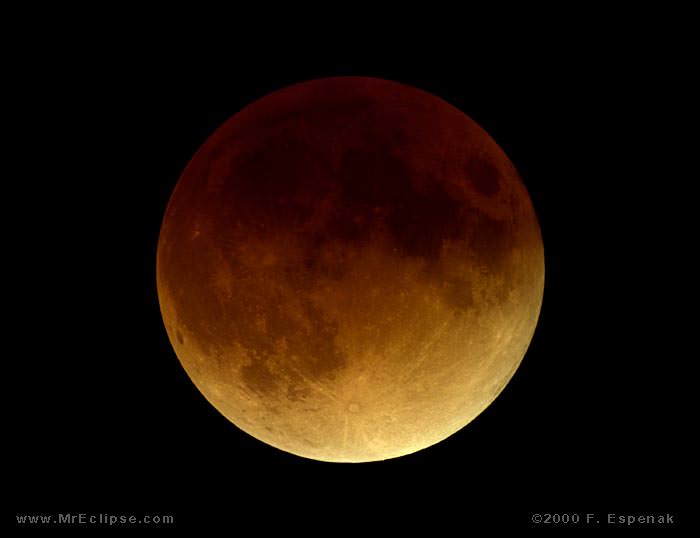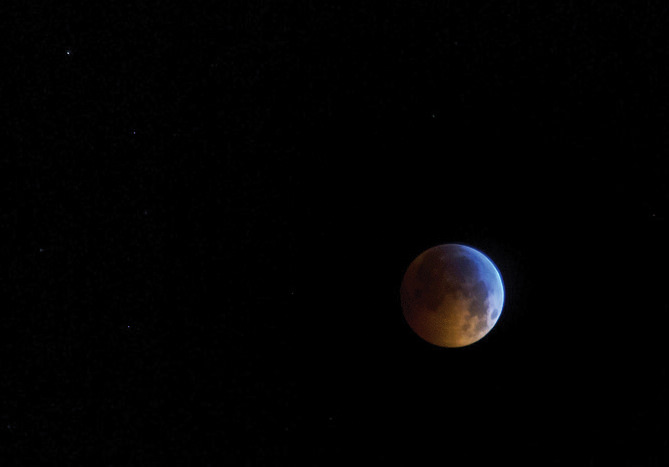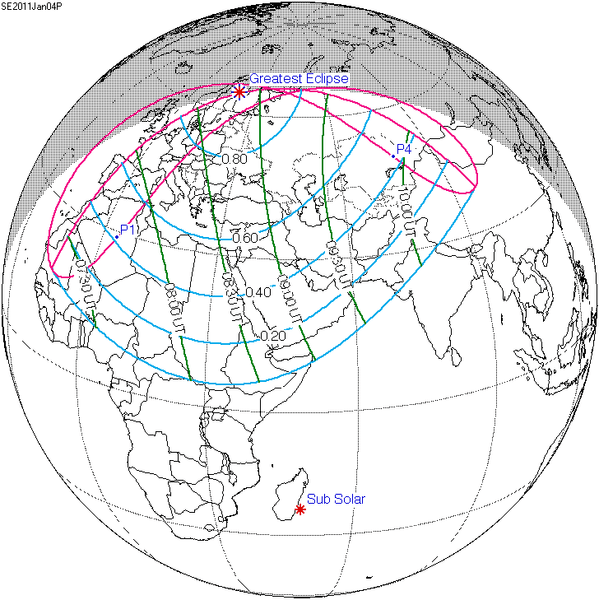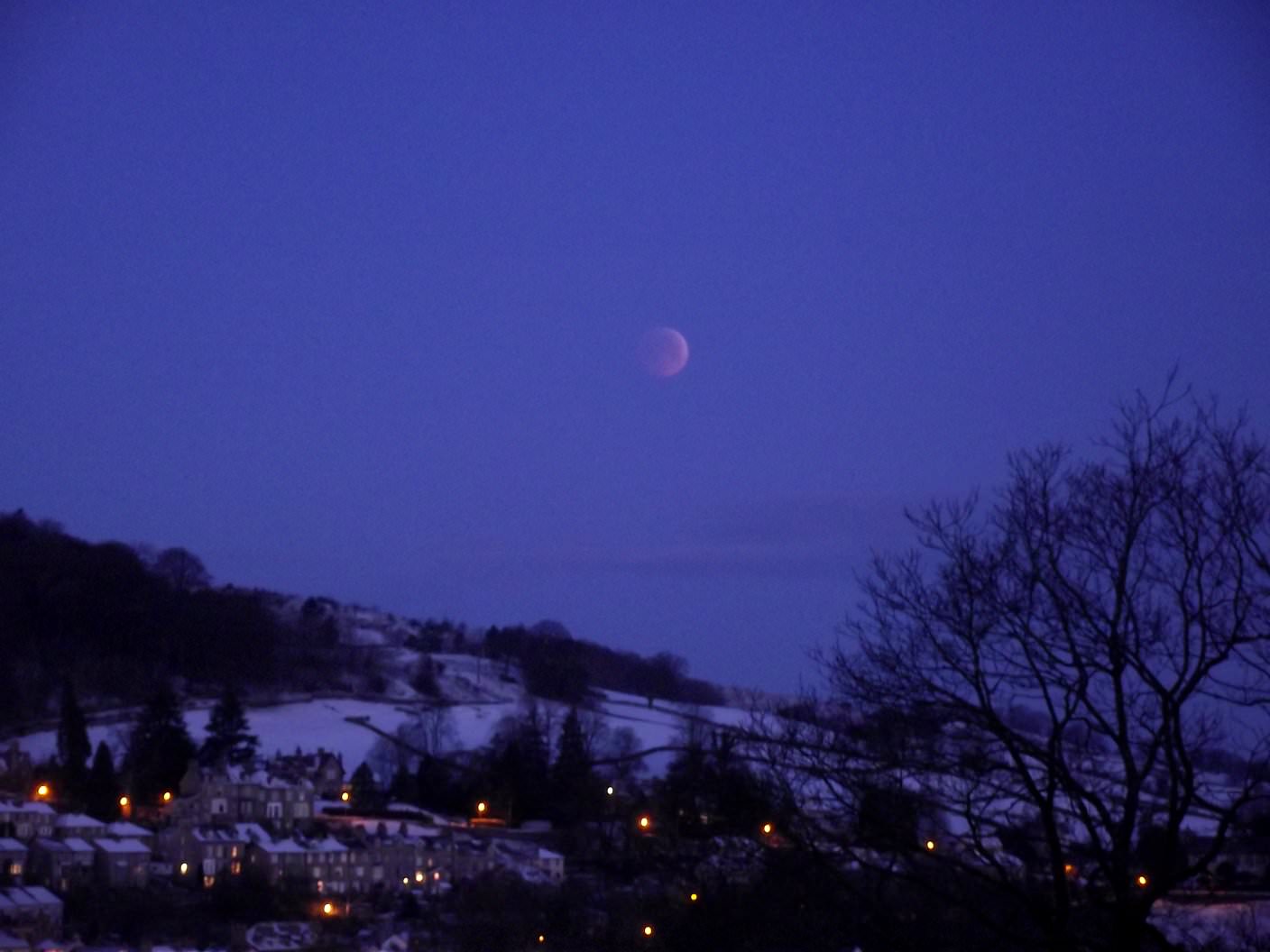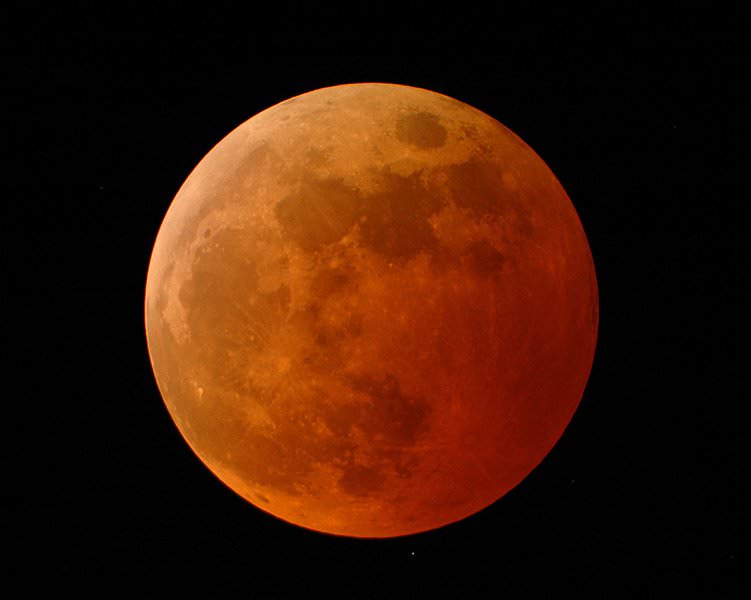What will the June 15th lunar eclipse look like from the Moon itself? Luckily, we’ve got the Lunar Reconnaissance Orbiter circling the Moon, and we can find out. However, most of the instruments on LRO will be powering down during the eclipse, but one instrument, called Diviner, will stay on. “It will be like a nap with one eye open!” the LRO spacecraft said on Facebook. The Diviner Lunar Radiometer instrument will record how quickly different areas on the moon’s day side cool off during the eclipse. Since large boulders cool more slowly than a fine-grained or dusty surface, Diviner will be able to see what areas are covered with boulders and what regions are blanketed by dust.
Continue reading “How LRO Plans to Watch the Lunar Eclipse from the Moon”
Coming Up… June 15th Total Lunar Eclipse LIVE
[/caption]
Don’t say we didn’t warn you ahead of time! The upcoming total lunar eclipse will happen on June 15, 2011… and it’s a rare one. This time the Moon will pass directly through the center of the Earth’s shadow cone – an event that hasn’t happened in 11 years and won’t happen again until 2018. The eclipse visibility path will be over Africa, and Central Asia, visible rising over South America, western Africa, and Europe, and setting over eastern Asia. In western Asia, Australia and the Philippines – visible just before sunrise. But before you just read on to another article because you can’t see it from where you live, remember I’ve got a few tricks up my sleeve…
Thanks to this fantastic magic we call the Internet, all you need to do is tune into our friends around the world! The first listing of our live eclipse broadcasters will be Astronomylive.com. Coordinating the eclipse project and different activities for this year is Mohan Sanjeevan, a science and science fiction writer from India. Since May 2011, Mohan volunteers as the Event & Broadcast Organizer of AstronomyLive covering his country. But Mohan is more than just a coordinater, he’s also involved in other venues like writing poetry – including science poems (freelance science writing for more than twenty years; writer of nano science and tech articles for Nano Digest, a monthly magazine from India), popularization of science and creating awareness on global warming, alternative sources of energy and making the planet a more livable place. Space and astronomy are his natural areas of interest. To top it off, Sanjeevan is also a researcher – full of implementable ideas for space and future technologies.
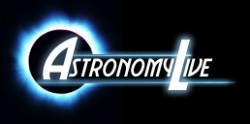 AstronomyLive is a center for LIVE astronomy and you can participate, too! Host your broadcasts of various types on this free service. Amateur astronomers, professional astronomers, observatories, astronomy associations and more are all very welcome. The current team consists of Sander Klieverik, Voskuh and Dennis from the Netherlands, LesD from the United States, Mohan Sanjeevan, Aakanksha, Prof. M. Jothi Rajan, Jhon Kennedy, Bhaskar, Abhilasha and Sanyam Kumar Shrivastava from India. All of these great people came together to share the view with you!
AstronomyLive is a center for LIVE astronomy and you can participate, too! Host your broadcasts of various types on this free service. Amateur astronomers, professional astronomers, observatories, astronomy associations and more are all very welcome. The current team consists of Sander Klieverik, Voskuh and Dennis from the Netherlands, LesD from the United States, Mohan Sanjeevan, Aakanksha, Prof. M. Jothi Rajan, Jhon Kennedy, Bhaskar, Abhilasha and Sanyam Kumar Shrivastava from India. All of these great people came together to share the view with you!
And there’s more…
 A free, live webcast from Bareket Observatory in Israel will also feature the total lunar eclipse on June 15, 2011. How do you get there? Simply click on this link for the Bareket Observatory Live Eclipse Broadcast! The hardworking group in Israel invite you to discover the Moon during the eclipse using hands-on eclipse activities. Conduct your own science projects using the live lunar eclipse feed! What a great opportunity for your students, family and friends!
A free, live webcast from Bareket Observatory in Israel will also feature the total lunar eclipse on June 15, 2011. How do you get there? Simply click on this link for the Bareket Observatory Live Eclipse Broadcast! The hardworking group in Israel invite you to discover the Moon during the eclipse using hands-on eclipse activities. Conduct your own science projects using the live lunar eclipse feed! What a great opportunity for your students, family and friends!
The great folks at Bareket Observatory have expanded tremendously over the years and now they’re pleased to announce the launch of the Astro-Edu Network, a free state-of-the-art astronomy education database for teachers, students and the general public. Among the goals of AStro-Edu is increased communication and understanding within the population of the Middle East using astronomy as the catalyst. Astro-Edu net can be translated to more than 60 different languages using the integrated translation module (move your cursor over the flag in the upper left to translate the materials).
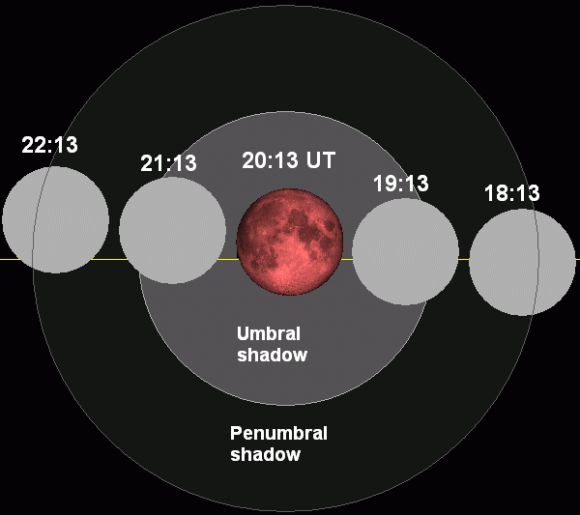
So don’t sit out the total lunar eclipse on June 15, 2011 – 17.00 – 23.00 UTC (GMT). Be sure to enjoy the event with our friends around the world!
And The Moon Is Eclipsed By The Earth
[/caption]
On June 15 there will be a total lunar eclipse visible from Australia, Indonesia, southern Japan, India, a large area of Asia, Africa, Europe and the eastern part of South America. This is expected to be one of the darkest eclipses ever (with a magnitude of 1.7), second only to the July 2000 eclipse.
Sadly it won’t be visible to viewers in North America, but much of the rest of the world should be treated to a wonderful show as the Moon slips into Earth’s shadow. Gradually growing darker from its western limb inwards, the Moon then gains a bluish cast which transitions to orange then deep red as it moves into light passing through the edge of Earth’s atmosphere (the same as what makes the colors of a sunset) and then eventually going almost completely dark before the process then reverses itself from the opposite side.
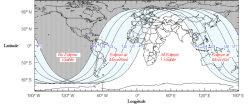
The entire eclipse will last 5 hours and 39 minutes, with a totality duration of 1 hour and 40 minutes. It will begin at 17:23 UT.
Viewers in Australia and eastern Asia will see the eclipse begin as the Moon is setting while those in Europe and South America will see it as the Moon is rising. Only locations in India, eastern Africa, the Middle East and western Asia will experience the entire eclipse.
This is the first of two total lunar eclipses in 2011; the next will take place on December 10.
I saw my first total lunar eclipse last December, which took place on the night of the winter solstice (December 21). It really was an amazing event to watch… in totality the Moon was colored a deep coppery red and really just seemed to be suspended among the stars – it felt like you could just reach up and pluck it from the sky! If you are in any of the areas where this next one is visible I encourage you to check it out for yourself!
Read more about lunar eclipses on MrEclipse.com.
Image: Jason Major
Great View! January 4 Solar Eclipse As Seen From Space
Here’s a unique view of the January 4 partial solar eclipse: ESA’s sun-watching microsatellite Proba-2 captured the conjunction of the spheres as the Sun, Moon and Earth all lined up in front of it. Shortly after the Moon partially blocked Proba-2’s view of the Sun, the satellite flew into Earth’s shadow. At that point – when the video seen here goes dark – the Sun, Moon, Earth and Proba-2 were all on the same line in space.
“This is a notable event,” said Bogdan Nicula of the Royal Observatory of Belgium (ROB), who calculated where and when this double-eclipse would happen. “It is a nice exercise to model the orbit and relative positions of all three celestial bodies.”
Continue reading “Great View! January 4 Solar Eclipse As Seen From Space”
January 4, 2011 – Partial Solar Eclipse Reminder
[/caption]
This year we’re in for a real treat! The citizens of planet Earth will be treated to not one – but four – partial solar eclipses and the first will begin on January 4. Ready to find out where and when? Then step inside….
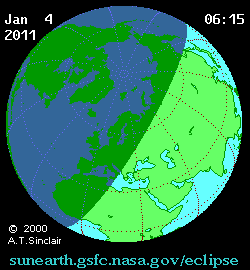
If you’re planning on watching, remember eye safety and use a proper solar filter for telescopes and binoculars. If it’s too late to get a filter or your budget won’t allow, why not try building your own pinhole projector? Get two pieces of cardboard – one will need to be white or have white paper attached to it for the screen. Cut a small square in the other piece of cardboard, and tape aluminum foil over the square. Now make a pinhole in the middle of the foil. This is your “projector”. With the Sun behind you, hold the pinhole projector as far away from the screen as you can. The farther away you are from the screen, the bigger your image will be. You won’t be able to see fine details like sunspots, but you’ll easily see the changes as the Moon passes over the face of the Sun!
Don’t be upset if you don’t catch this eclipse. The next will happen on June 1, 2011 and be for the eastern region of Asia, northern region of North America and some islands of the North Atlantic. Again? How about July 1, 2011 and this time be over the Indian Ocean and the small islands in this ocean. Still not found you? Then how about November 25, 2011 and southern regions of Africa and Australia and whole of Antarctica!
Want to watch the eclipes live? Then join the cast and crew at Bareket Observatory and at AstronomyLive.com!
Red Moon, Red Planet

[/caption]
In this season of Christmas tidings, many of us were blessed to witness the eerie Red Moon of the total lunar eclipse a few nights ago on Dec. 21. Here in “bonechilling” New Jersey, it was miraculously crystal clear the entire night from the beginning around 1:30 a.m. EST to the end – about three and one half hours later at around 5 a.m.
UPDATE: Check out more readers “Red Moon, Red Planet” astropix contributions below !
The eclipse occurred as the moon passed through the Earth’s inner dark shadow, or umbra and changed dramatically to varying shades of red, orange and brown.
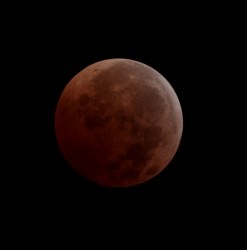
Well all this redness hanging in the sky during totality caused me to ponder Mars – the Red Planet – especially with the avalanche of good news streaming back lately.
And the wispy white light at near total eclipse harkened to the Martian polar ice caps.
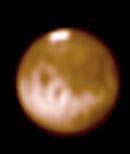
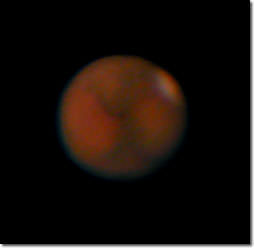
So please send your telescopic shots and descriptions of the Red Planet and/or the Red Moon and I’ll post them here. Email kremerken at yahoo dot com or post as comments to add here.
Looking up at the sky it was easy to imagine Opportunity newly arrived at the gorgeous Martian crater Santa Maria, hunting for minerals spotted from orbit that could influence the search for life, as Odyssey circles about at a record setting pace and transmits those tell tale clues back to scientists waiting on Earth.
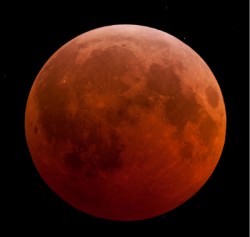
Despite the shadow the moon does not completely disappear. The red moon’s glow was caused by sunlight refracted through the earth’s atmosphere and cast upon the lunar surface. The hue varies depending on a variety of atmospheric conditions and can be intensified by floating clouds of volcanic ash and dust. The recent volcanic eruptions at Mount Merapi in Indonesia in October and at Mount Eyjafjallajökull in Iceland last April sent massive plumes of particles skyward which may have influenced the thrilling event.
Red Moon, Red Planet. One day we’ll journey there and back again.
———
Send me your astropix of Red Moon and/or Red Mars to post here:
Check out these gorgeous views of Mars in January 2010 from Efrain Morales Rivera at the Jaicoa Observatory in Aquadilla, Puerto Rico
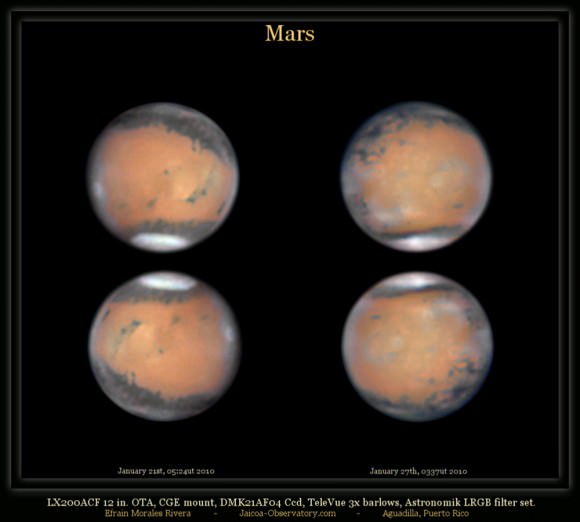
From Robert Vanderbei of Amateur Astronomers Association Of Princeton in New Jersey; A Lunar Eclipse Montage ! Just ahead of the monster blizzard which struck the northeast Corridor of the US on Dec 26.
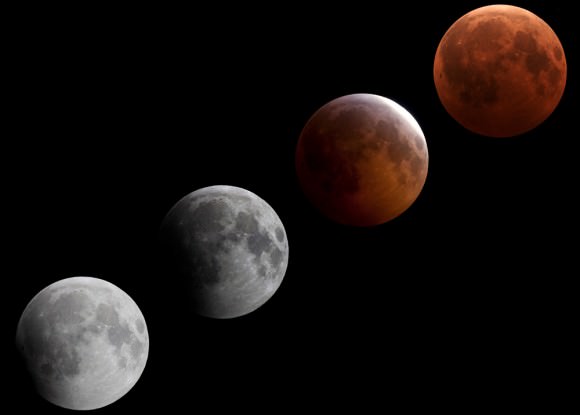
Some pictures of the eclipse put together as a composite from beginning to totality by Russell King of Willingboro Astronomical Society, New Jersey.
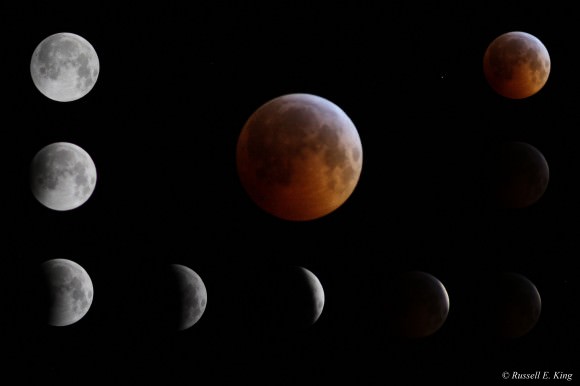
Upcoming Solar Eclipse on January 4, 2011
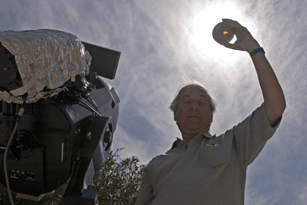
[/caption]
Some of the world will be able to greet the first part of the new year with a solar eclipse. On the morning of Tuesday, January 4, 2011, an eclipse of the Sun will be widely visible across Europe and as far east as India. The eclipse won’t be visible in North and South America, however. Jay Pasachoff of Williams College in the US is the Chair of the International Astronomical Union’s Working Group on Eclipses, and says that even at a maximum, this eclipse will be only partial, with some of the Sun always visible. Because the Sun is too bright to look at safely, Pasachoff stresses that special solar filters or projection methods should always be used to protect the eyes.
Pasachoff will be in Tel Aviv to view the eclipse, and since partial eclipses are usually not very scientifically useful, he is looking forward to just enjoying the eclipse instead of scrambling to set up various scientific equipment.
“Partial eclipses are fun, and much more relaxing for a total-eclipse scientist like me, since the pressure on me is low and nothing happens too fast,” he told Universe Today. “Seeing a partial or other solar eclipse happen right on time, to the second, can be inspirational to students to study hard so that they, too, can understand the Universe.”
This will be Pasachoff’s 52nd solar eclipse.
Radio astronomers do find partial eclipses useful, as with a radio telescope, or in the ultraviolet or x-rays from spacecraft, scientists can use the timing of when solar active regions are covered and uncovered to study the structure of solar storms in better detail than is otherwise possible, Pasachoff said.
For this eclipse, people in Western Europe will find the Sun already eclipsed as the day begins, with the eclipse lasting about 80 minutes more. On January 4, the Moon will gradually cover the Sun, over a period of about 3 hours. At maximum, the eclipse will be at the horizon at sunrise in England, with 75% of the Sun’s diameter covered, and then gradually emerge over the next hour and 20 minutes. In Paris or Berlin, 80% of the Sun will be covered near sunrise. Farther east, the Sun will be a bit higher in the sky at maximum, 22° high with 67% covered in Athens. In Israel and Egypt, the Sun will be 33° high with over 55% coverage at maximum.
The most important thing, Pasachoff said, is to view an eclipse safely.
“Whenever the ordinary Sun is visible, even only part of it, you should not stare at it,” he said. “Special solar filters are available cheaply, or dense welders’ glass will do. Another method of seeing that the Sun is eclipsed is to punch a hole a few millimeters across in a piece of cardboard and hold it up to the Sun while you face away from the Sun and see the Sun’s image projected on the ground or onto another piece of cardboard. This method is called projection with a pinhole camera. It is rare that haze or clouds are sufficient to reduce the Sun’s intensity enough that one can see a partially covered Sun safely.”
2011 is unusual in that it has only four partial solar eclipses, for all of which the darkest part of the Moon’s shadow passes off the Earth’s surface. In 2012, an annular eclipse in which the Moon’s disk is a little too small to cover the entire Sun will pass from Japan over the Pacific to California and farther into the U.S. on May 20. On November 14, 2012, a total solar eclipse, in which it becomes dark as twilight, will start in northeastern Australia and cross a broad swath of the South Pacific.
For further information:
NASA’s website from Fred Espenak with maps, and tables for cities around the world.
Webcasts:
Israel Astronomy Society at Givatayim Observatory
www.astronomy.org.il
www.education.org.il
University of Barcelona’s Department of Astronomy and Meteorology.
Bareket Observatory, a private observatory in Israel.
An Artistic Look at the Lunar Eclipse
[/caption]
What do you do if you’re watching the lunar eclipse but don’t have your camera? Make a sketch, just like the astronomers of old. Amateur astronomer Ted Judah from California enjoyed the eclipse, but since he was away on a trip with his family and “there was no room for my astrophotography equipment in the car,” he said, Ted resorted to drawing what he witnessed. Lovely.
Below is another artistic view of the eclipse, although taken by a camera.
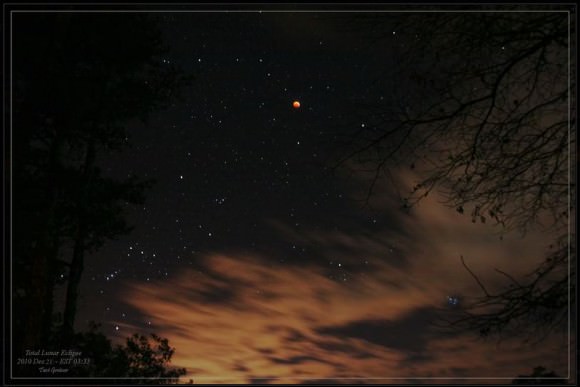
Tavi Greiner took this image from her yard in Shallotte, North Carolina. Her description: “The darkened sky beneath Totality’s copper Moon reveals Orion to the left and Pleiades to the right.” See more of her images at “A Sky Full of Stars.”
Lunar Eclipse Images From Around the World, Dec. 21, 2010
[/caption]
For the first time in almost four centuries a total lunar eclipse coincided with the solstice – mid-winter for northern hemisphere skywatchers and mid-summer for the southern hemisphere. For those with a clear view of the sky (I was not that lucky!), the entire event was visible from North America, Greenland and Iceland, while western Europe saw the beginning stages before moonset and western Asia got the later stages after moonrise. Australia also saw the late stages of the eclipse.
People with clear skies in the northern hemisphere saw the Moon transformed into a “coppery orb,” as Tony Hoffman from Queens, New York called it (see his image below.) The Moon didn’t disappear completely, as the residual light from its surface is refracted by our atmosphere, resulting in the Moon turning a coppery, red or brown color. The eclipse lasted for about three and a half hours. See some images and videos from around the world, below. Clicking on each image will bring you to the original source.
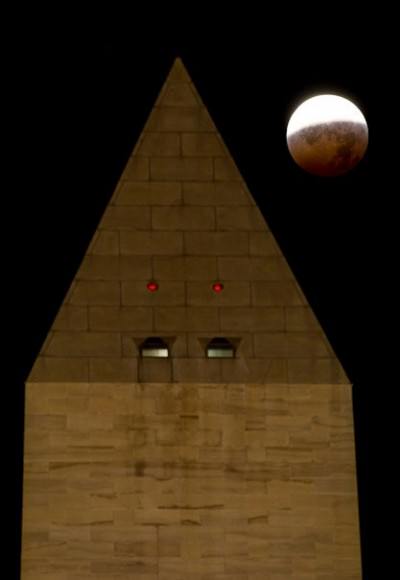
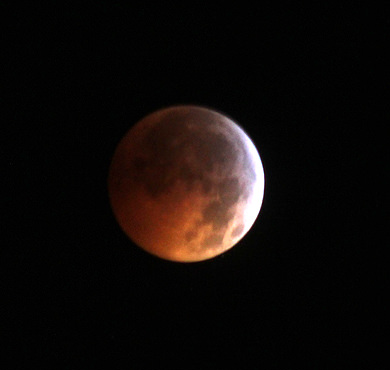
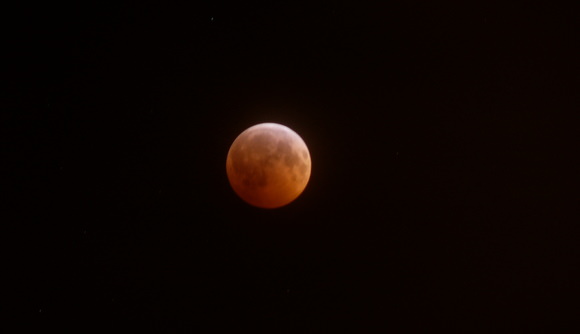
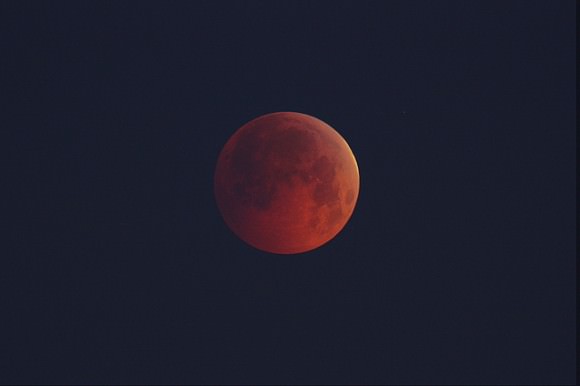
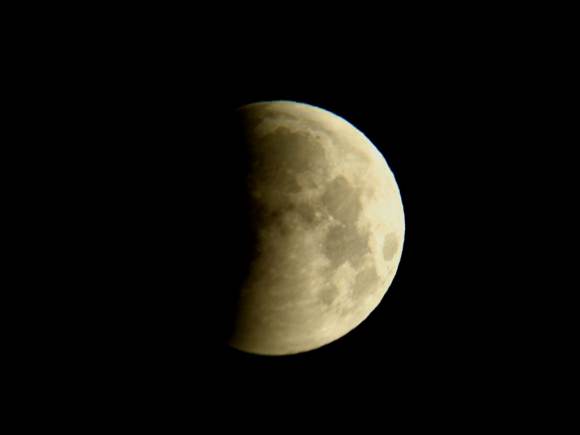
You can see the more pictures and the write-up Stu did about the eclipse on his website, Cumbrian Sky: Eclipse-Watching from Narnia.
Astronomer Amanda Bauer took several images of the eclipsed Moon rising over Sydney, Australia, as seen below. See her website, Astropixie, for more images she took of the event.
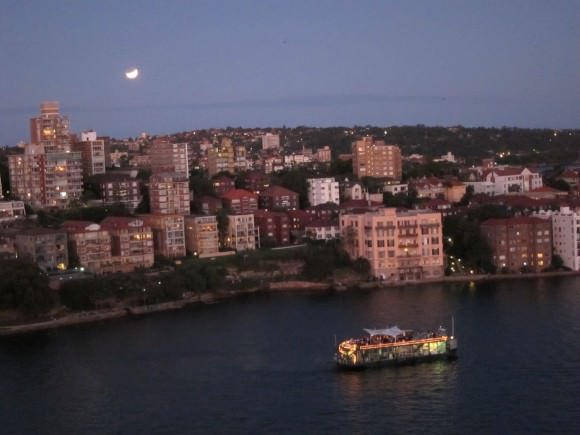
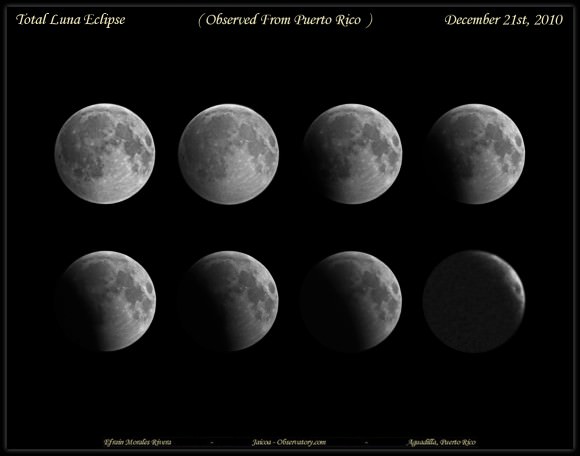
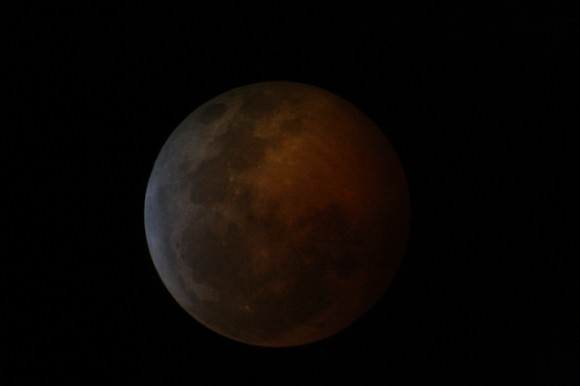

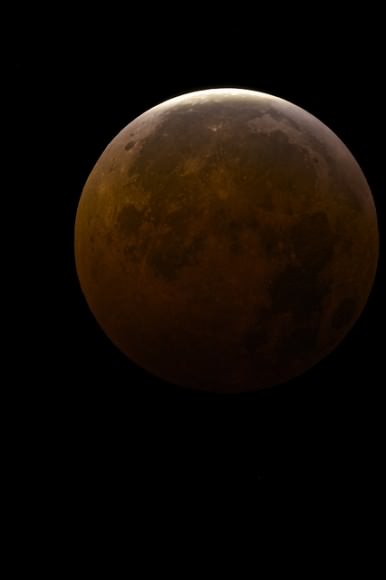
Former space shuttle technician Jen Scheer (@flyingjenny on Twitter) got up earlier than usual (she takes a daily sunrise picture from around Kennedy Space Center each morning) to capture some great shots of the eclipse. You can see more of her images at her Flickr page.
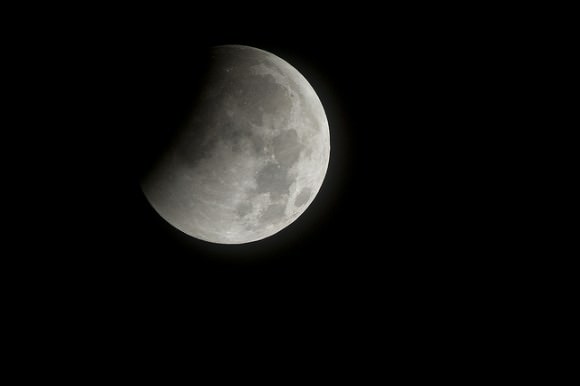
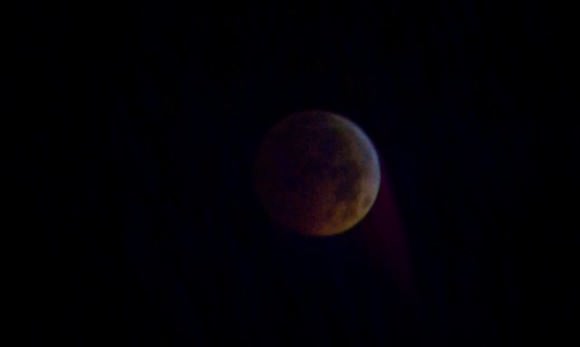
Here’s a video taken from Savannah, Georgia in the US:
And another video from UT frequenter, Brent (aka Hellobozos) from Orlando Florida. He took 6 second avi’s every 5 minutes for 6 hours, from 12:30am to 6am EST:
And one more from Carl Hamilton from Bowie, Maryland:
You can also see a great collection of images on JPL’s I’m There Flickr Group, this collection at a German astronomy website called ASTROTREFF, this amazing set of images from Slovakia, Carolyn Collins Petersen has a bunch of images she took from near Boulder Colorado, and this NASA Flickr page.
Here are some more images sent in by readers:
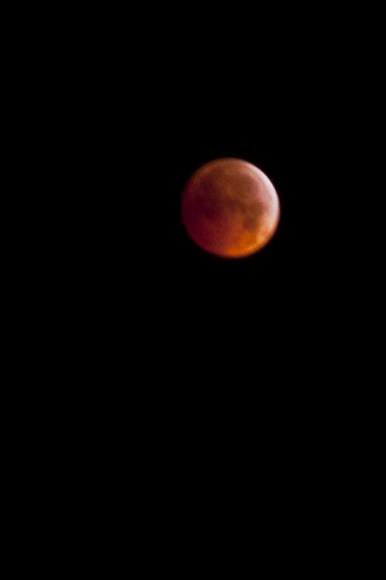
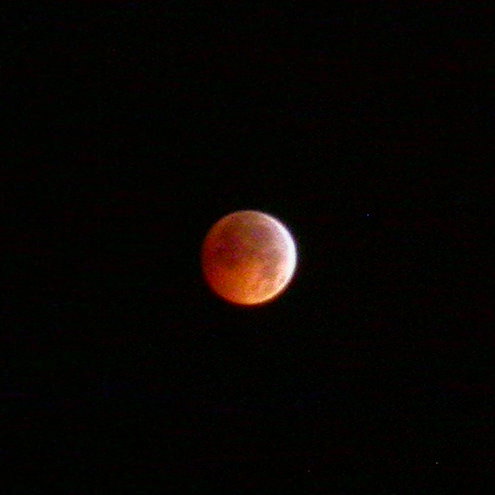
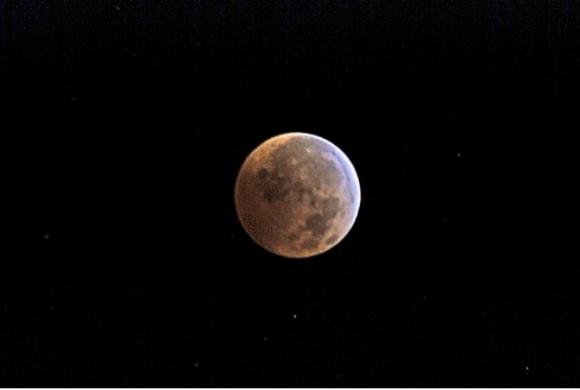
This image was taken by photographer John O’Connor, who normally takes images of rockets and spacecraft (see his website NASATech, for amazing virtual tours of spacecraft, launchpads and more). He was up in the middle of the night to take images of space shuttle Discovery’s intended rollback from the launchpad to the Vehicle Assembly Building, but the rollback was delayed because of a technical problem.
“I intended to take a couple of quick shots of totality before heading out but ended up spending 45 minutes shooting the moon, as they say,” John wrote me. “This is my first attempt at astrophotography. I shot it with a 300 mm fixed focal length lens with a doubler on it. With the 1.5 multiplier factor on the 2/3 size sensor, it was about 900 mm focal length. It was 4 second shot at 100 ISO with an f4.5 aperture, as wide as the lens would let me go. Note the smudged stars. Even at a 4 second exposure the Earth’s rotation is evident, blurring, ever-so-slightly, the lunar disk.”
Total Lunar Eclipse Information – December 21, 2010
Are you ready? As promised, here comes more detailed information on the 2010 total lunar eclipse. Step inside and find out where and when to watch!
The eclipse begins for eastern North America on Tuesday morning, Dec. 21st, at 1:33 am EST and occurs on Monday night, Dec. 20th, at 10:33 pm PST for western North America. At that time, Earth’s shadow will appear as a dark-red crescent at the edge of the lunar disk. It takes about an hour for the Earth’s shadow to fully encompass the visible side of the Moon. Totality commences at 02:41 am EST (11:41 pm PST) and lasts for 72 minutes. Western Europe and the northwestern portion of Africa will also be treated to a portion of the eclipse at moonset. The point of deepest shadow will occur at 08:17 UT and totality ends 36 minutes later at 08:53 UT. At that time, a silver sliver will once again appear along the lunar limb, where for one hour and eight minutes it will continue until the Moon passes out of the umbral shadow at 10:01 UT. From there it will pass into the penumbral shadow for an additional hour and four minutes until the show ends at 11:05 UT.
Where will the Moon appear? Of course it will be along the ecliptic plane and in very good company – riding high above Orion. Be sure to look for a triple red treat as the show forms a triangle with blushing Betelgeuse and ruddy Aldebaran. As the Moon darkens, be sure to look for wonderful unaided eye deep space objects you can’t see during a full Moon – like the Plieades (M45) and the Great Orion Nebula (M42). What a Christmas treat!
Photographing or videotaping a total lunar eclipse is quite easy, but remember if you live in a cold climate that there are a few very important rules to follow. Number one is to be sure to protect your hands. It’s very easy to get involved with the equipment and ignore what seems like a slight discomfort. You don’t want to experience freezing your fingers to a metal surface or risking frostbite! The second rule is to remember that cold batteries drain very, very quickly. You can easily avoid frustration by simply keeping spares somewhere handy next to your skin. Of course, getting to them might be a ticklish situation! The last rule to remember is simply to dress for success. Multiple loose layers of clothing, hat, gloves and proper footgear are a must where the winter season means bitter cold temperatures.
Now all that’s left is just to let the hours count down… and enjoy!
Fun Facts from NASA: This lunar eclipse falls on the date of the northern winter solstice. How rare is that? Total lunar eclipses in northern winter are fairly common. There have been three of them in the past ten years alone. A lunar eclipse smack-dab on the date of the solstice, however, is unusual. Geoff Chester of the US Naval Observatory inspected a list of eclipses going back 2000 years. “Since Year 1, I can only find one previous instance of an eclipse matching the same calendar date as the solstice, and that is 1638 DEC 21,” says Chester. “Fortunately we won’t have to wait 372 years for the next one…that will be on 2094 DEC 21.”

